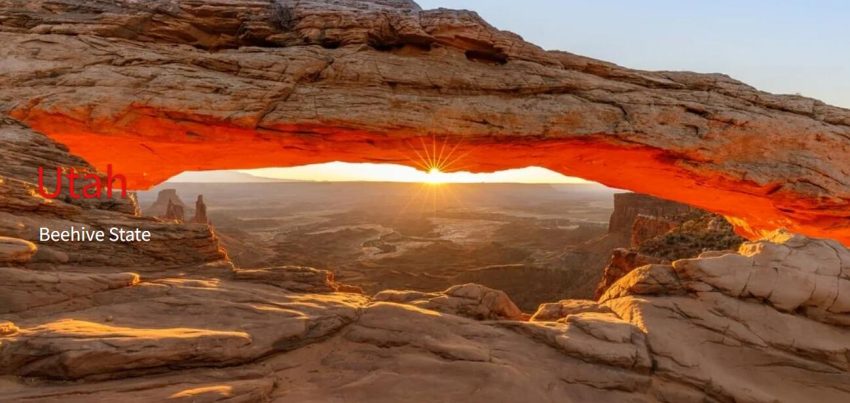Utah Information
Utah, abbreviated UT, is the State of America nicknamed “the Beehive State”. This name symbolizes the state’s industry and the way its inhabitants work together.
Salt Lake City is the state capital and largest city. About 62% of the residents of this state are Mormon. Utah is best known for its beautiful nature. Even if you like winter sports, you can safely visit Utah.
Salt Lake City is also worth a visit. In 2000, this city was one of the host cities of the Winter Olympics. In addition, you have many buildings that represent Mormon religion and culture.
Geography
Utah is located in the ‘Intermountain West’ region, just west of the Rocky Mountains. The state borders Idaho, Wyoming, Colorado, Arizona and Nevada, as well as New Mexico through the Four Corners. Utah is a large state, it measures a maximum of 555 kilometers from north to south and 445 kilometers from west to east. Utah’s borders are in the shape of a square. Eastern Utah is predominantly mountainous with isolated mountain ranges and broad canyoned valleys. The 4,120-meter high Kings Peak is the highest point in the state. Western Utah is flatter and consists of almost uninhabited desert. Special is the Great Salt Lake in the north, and the Bonneville Salt Flats located next to it. Utah has several national parks, such as Zion National Park, Bryce Canyon National Park, Capitol Reef National Park, Arches National Park and Canyonlands National Park. The south of the state has special features, such as Monument Valley, Valley of the Gods, the immense Grand Staircase-Escalante National Monument and the Glen Canyon National Recreation Area.
Few major rivers flow through Utah, the most important being the Colorado River in the southeastern part of the state, of which the Green River is a major tributary. Utah is predominantly barren, only higher mountain areas are forested. The mountain ranges run north-south through Utah, with a large concentration of high mountain ranges in the northeast of the state. In addition to the Great Salt Lake, Utah Lake and Bear Lake are also large lakes.
History
The area that now comprises the state of Utah had been inhabited since 10,000 BC, probably by small groups of hunters living in caves near Lake Bonneville. Around 400 AD. the Anasazi Indians came to the area and built their famous pueblos (villages). The Anasazi grew maize and beans in the area, but abandoned it again around 1250, probably because of a major drought.
The first whites visited the area in the 18th and 19th centuries and encountered Shoshone Indians, consisting of Paiute, Gosiute and Ute Indians. The Ute in eastern Utah already owned horses and lived off buffalo hunts. Until 1825, however, the number of whites frequenting the area remained low.
From that year on, trading posts were also set up in the area, mainly to stimulate the fur trade; permanent habitation of whites, however, did not get underway due to the dry climate. That did not happen until 1847, when a group of Mormons led by Brigham Young settled in the Great Salt Lake area. Young and his Mormons had fled the eastern United States because of the violent religious discrimination they had experienced there.
The Mormons were determined to turn the dryland into a green paradise and sent hordes of settlers from Salt Lake City in all directions. By 1860 Utah already had 150 communities with a total of 40,000 people who were self-supporting through irrigation.
In 1869, after the completion (at Promontory, Utah) of the railroad connecting the east and west of the US, mining began to emerge throughout Utah. These were not the Mormons, as Brigham Young encouraged them to optimize agriculture in the area first. This gave non-Mormons an opportunity to tighten their grip on the territory.
Between 1860 and 1890, Utah’s population grew to over 200,000 (90% of whom were Mormon), but Utah was still not a US state. The Mormons had tried to register Utah since 1849, but the US had refused. First, some Mormon practices, including polygamy, had to be renounced. When that happened, Utah finally became the 45th state of the US in 1896.
Economy
Utah ranks high on many economic indicators and is one of the more prosperous states in the country. The economy has traditionally been mining, especially large open mines west of Salt Lake City. Oil and gas is extracted in eastern Utah. Tourism plays an important role, especially the national parks in the south of the state are much visited. There are also ski areas around Salt Lake City.
| Abbreviation: | UT |
| Nickname: | Beehive State |
| Joined the US as the 45th state on: | January 4, 1896 |
| Capital city: | Salt Lake City |
| Census: | 3.117.222 |
| Surface: | 220,080 km² |
| Geography: | Bordering Wyoming, Colorado, New Mexico, Arizona, Nevada, and Idaho |
| Governor: | Gary Herbert |
| State motto: | Industry |
| California official website: | utah.gov |

